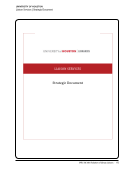82 · Survey Results: Survey Questions and Responses
Two lines, science and humanities supervisors who are also liaisons and then to AD.
36. Who is responsible for evaluating liaisons’ performance? N=67
Liaisons report to various supervisors who are also responsible for evaluation of liaison 32 48%
Liaisons report to various supervisors, while other library leaders provide input to evaluation 19 28%
Liaisons all report to the same supervisor 8 12%
Liaisons all report to the same set of supervisors 3 5%
Liaison performance is not evaluated 1 2%
Other evaluation method 4 6%
Please briefly describe the other evaluation method. N=4
Evaluation is part of our faculty processes and includes annual reviews for the untenured and five-year reviews for the
tenured, as well as the reappointment and tenure reviews.
In addition to supervisor, there is peer evaluation through librarian contractual process.
Liaisons are evaluated by their primary supervisor, typically the campus library director. Input on evaluation is provided
by AD for Collections, Director for Liaison and Instruction Services, Head of Research and Reference Services also the
chair of any university library committee on which they serve.
The two heads of Liaison Services jointly evaluate liaisons’ performance.
37. What criteria are used to evaluate liaison responsibilities? N=66
Evaluation criteria include liaison functions 33 50%
Goal-based evaluation 20 30%
Evaluation criteria do not specifically cover liaison functions 3 5%
Liaisons are not evaluated 0 0%
Other criteria 10 15%
Please briefly describe the other criteria. N=10
All librarians submit a faculty statement of activities. Annual reviews are based on professional performance (including
student teaching evaluations where applicable), service, and creative activity/scholarship.
Both liaison functions and goal-based
Evaluation includes evaluation criteria and goal-based evaluations.
Evaluations are very open-ended. Some specifically cover liaison functions and some do not. HSL uses goal-
based evaluations.
Liaisons set specific goals and objectives and the appraisal process addresses them.
Our evaluation criteria include liaison functions, as well as goal-based evaluation.
Peer review process
Two lines, science and humanities supervisors who are also liaisons and then to AD.
36. Who is responsible for evaluating liaisons’ performance? N=67
Liaisons report to various supervisors who are also responsible for evaluation of liaison 32 48%
Liaisons report to various supervisors, while other library leaders provide input to evaluation 19 28%
Liaisons all report to the same supervisor 8 12%
Liaisons all report to the same set of supervisors 3 5%
Liaison performance is not evaluated 1 2%
Other evaluation method 4 6%
Please briefly describe the other evaluation method. N=4
Evaluation is part of our faculty processes and includes annual reviews for the untenured and five-year reviews for the
tenured, as well as the reappointment and tenure reviews.
In addition to supervisor, there is peer evaluation through librarian contractual process.
Liaisons are evaluated by their primary supervisor, typically the campus library director. Input on evaluation is provided
by AD for Collections, Director for Liaison and Instruction Services, Head of Research and Reference Services also the
chair of any university library committee on which they serve.
The two heads of Liaison Services jointly evaluate liaisons’ performance.
37. What criteria are used to evaluate liaison responsibilities? N=66
Evaluation criteria include liaison functions 33 50%
Goal-based evaluation 20 30%
Evaluation criteria do not specifically cover liaison functions 3 5%
Liaisons are not evaluated 0 0%
Other criteria 10 15%
Please briefly describe the other criteria. N=10
All librarians submit a faculty statement of activities. Annual reviews are based on professional performance (including
student teaching evaluations where applicable), service, and creative activity/scholarship.
Both liaison functions and goal-based
Evaluation includes evaluation criteria and goal-based evaluations.
Evaluations are very open-ended. Some specifically cover liaison functions and some do not. HSL uses goal-
based evaluations.
Liaisons set specific goals and objectives and the appraisal process addresses them.
Our evaluation criteria include liaison functions, as well as goal-based evaluation.
Peer review process












































































































































































































